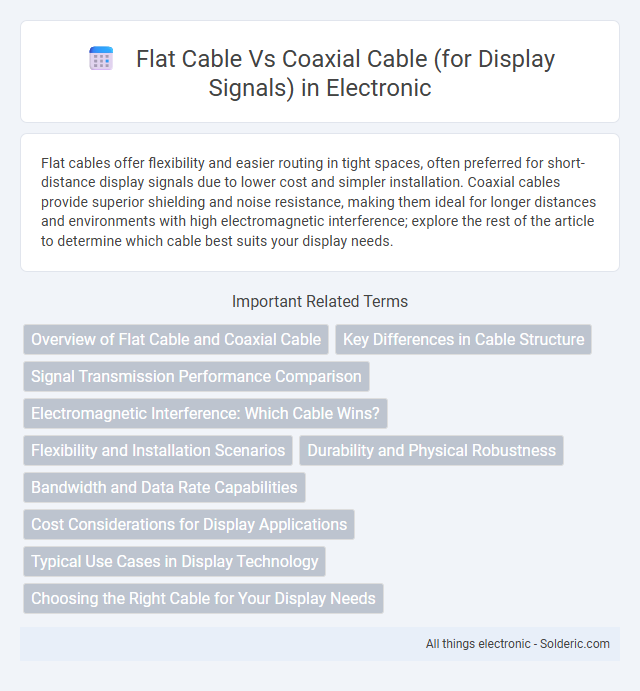Flat cables offer flexibility and easier routing in tight spaces, often preferred for short-distance display signals due to lower cost and simpler installation. Coaxial cables provide superior shielding and noise resistance, making them ideal for longer distances and environments with high electromagnetic interference; explore the rest of the article to determine which cable best suits your display needs.
Comparison Table
| Feature | Flat Cable | Coaxial Cable |
|---|---|---|
| Design | Thin, flat ribbon-like structure | Round with central conductor and shielding |
| Signal Type | Low to moderate frequency, multi-conductor signals | High-frequency signals with strong shielding |
| Shielding | Minimal to none, prone to interference | High shielding effectiveness against EMI/RFI |
| Flexibility | Highly flexible, easy routing in tight spaces | Less flexible due to thick shielding |
| Signal Integrity | Suitable for short distances, lower noise immunity | Maintains integrity over longer distances |
| Typical Use | Internal display connections (e.g., LVDS cables) | External display signals, RF video transmission |
| Cost | Generally lower cost | Higher cost due to shielding and construction |
| Installation | Simple, compact installations | Requires careful handling for connectors and shielding |
Overview of Flat Cable and Coaxial Cable
Flat cables feature a flexible, ribbon-like design with parallel conductors ideal for compact, low-profile display signal connections, offering ease of routing in tight spaces. Coaxial cables consist of a central conductor surrounded by insulation and a grounded shield, providing superior resistance to electromagnetic interference, which ensures high-quality signal transmission over longer distances. Choosing the right cable depends on your specific display requirements, balancing flexibility, signal integrity, and installation constraints.
Key Differences in Cable Structure
Flat cables for display signals consist of multiple parallel conductors arranged in a flat, ribbon-like structure, allowing for flexibility and easy cable management in tight spaces. Coaxial cables feature a central conductor surrounded by an insulating layer, a metallic shield, and an outer jacket, which provides superior protection against electromagnetic interference (EMI) and signal degradation. The structural difference impacts signal transmission quality, with coaxial cables typically offering better shielding, while flat cables provide compactness and ease of installation.
Signal Transmission Performance Comparison
Flat cables offer excellent signal transmission for display signals by minimizing crosstalk and electromagnetic interference (EMI) due to their parallel conductor arrangement. Coaxial cables provide superior shielding with a central conductor surrounded by a grounded shield, ensuring high-quality signal integrity over longer distances and reducing signal loss. Your choice between flat cable and coaxial cable will depend on factors like required transmission distance, susceptibility to interference, and flexibility needs for the display application.
Electromagnetic Interference: Which Cable Wins?
Flat cables exhibit lower susceptibility to electromagnetic interference (EMI) due to their parallel conductor layout and consistent spacing, which minimizes crosstalk and signal degradation in display signals. Coaxial cables, designed with a central conductor encased in a shield, provide exceptional EMI shielding, effectively blocking external noise especially in high-frequency signal transmission. For environments with intense EMI, coaxial cables generally outperform flat cables, but flat cables offer sufficient EMI resistance for most standard display signal applications.
Flexibility and Installation Scenarios
Flat cables offer superior flexibility and are ideal for tight spaces or dynamic applications where frequent bending occurs, such as in foldable displays or compact electronics. Coaxial cables provide robust shielding for signal integrity but are less flexible, making them better suited for fixed installations with minimal movement. Installation scenarios requiring easy routing through narrow channels or around sharp bends benefit from flat cables, while environments demanding high electromagnetic interference resistance favor coaxial cables.
Durability and Physical Robustness
Flat cables offer superior flexibility and ease of installation in tight spaces but generally have lower durability compared to coaxial cables. Coaxial cables feature a robust design with a solid outer shield that provides excellent protection against physical damage, electromagnetic interference, and signal degradation. For your display signals, choosing coaxial cables ensures enhanced longevity and reliable performance in demanding or high-movement environments.
Bandwidth and Data Rate Capabilities
Flat cables generally support moderate bandwidth and data rates suitable for short-distance display signals, typically handling up to several gigabits per second with reduced crosstalk due to their parallel conductor layout. Coaxial cables offer higher bandwidth and superior data rate capabilities, often exceeding 10 Gbps, attributed to their shielded design minimizing electromagnetic interference and signal loss over longer distances. For high-resolution displays and longer cable runs, coaxial cables provide more reliable signal integrity and faster data transmission rates compared to flat cables.
Cost Considerations for Display Applications
Flat cables generally offer a more cost-effective solution for display signal transmission due to their simpler construction and lower material costs compared to coaxial cables. Coaxial cables, while more expensive, provide superior signal integrity and shielding, which is crucial for high-resolution or long-distance display applications. Your choice should balance budget limitations with performance needs, prioritizing flat cables for cost efficiency and coaxial for enhanced signal quality.
Typical Use Cases in Display Technology
Flat cables are commonly used in display technology for internal connections within devices, such as linking LCD panels to controller boards, due to their flexibility and space-saving design. Coaxial cables excel in transmitting high-frequency display signals over longer distances with minimal interference, making them ideal for external connections like connecting video sources to monitors or televisions. When selecting between the two, consider your specific application requirements for signal integrity, distance, and device form factor.
Choosing the Right Cable for Your Display Needs
Choosing the right cable for your display needs depends on signal integrity, flexibility, and installation environment. Flat cables offer excellent flexibility and easy routing in tight spaces, making them ideal for compact or dynamic display setups, while coaxial cables provide superior shielding and bandwidth for high-frequency, long-distance signal transmission with minimal interference. Evaluating the display resolution, cable length, and environmental factors ensures optimized performance and reliable visual quality.
Flat Cable vs Coaxial Cable (for display signals) Infographic

 solderic.com
solderic.com